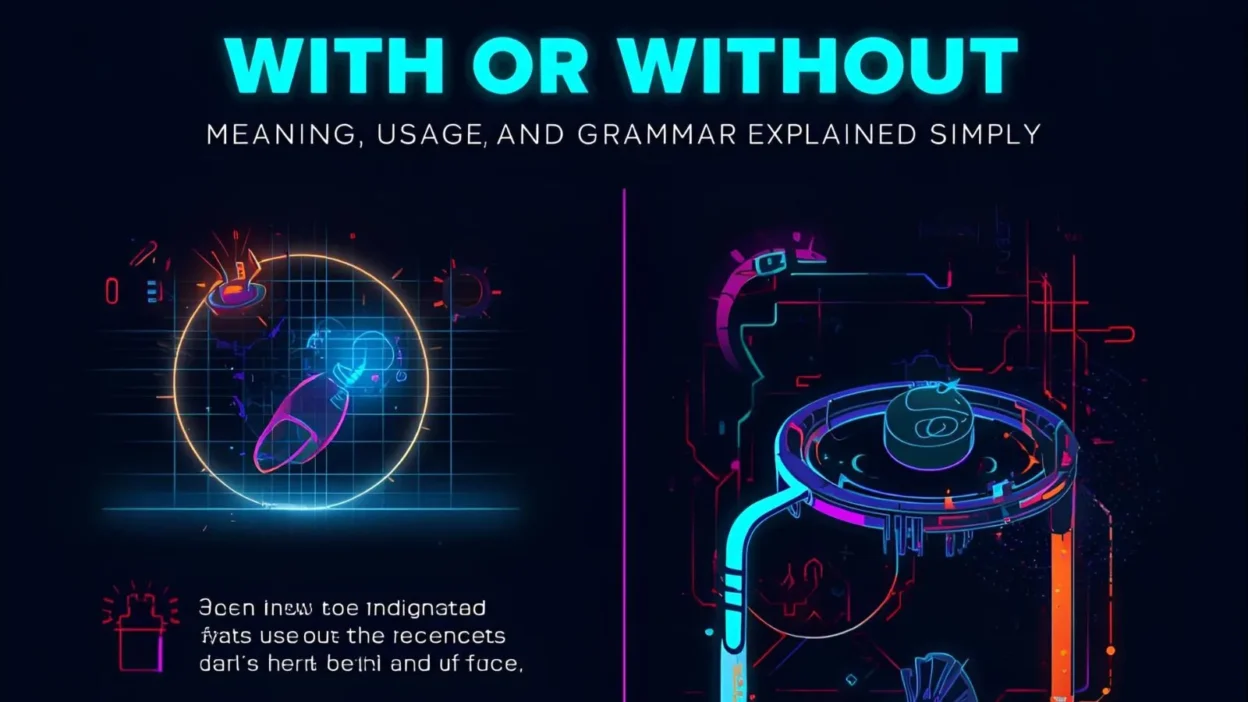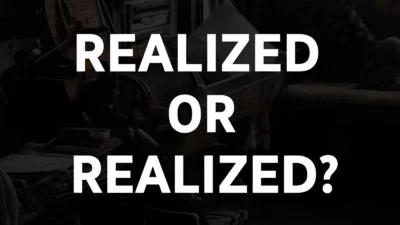People often wonder whether to use “with or without” in writing, or even whether both words belong together.
Is it “with or without” or some alternative phrase? What nuance does it carry? This article addresses that confusion head-on.
The phrase “with or without” is extremely common: you see it in instructions (“Take the supplement with or without food”), advertising (“Available with or without sugar”), or in everyday speech (“Could you come with or without your umbrella?”).
Many search for it because they’re unsure if they’re using it correctly, especially in formal writing.
Others ask about subtle variants like “with & without,” “with and without,” or whether there’s any spelling or meaning difference across dialects.
In short: this article gives you a quick answer, then dives into its origin, dialect differences, common mistakes, example usage, usage trends, and advice for which form to choose.
By reading this, you’ll gain confidence using “with or without” accurately in emails, essays, social media, or reports.
[with or without] – Quick Answer
Quick Answer:
“With or without” means including or excluding something—that is, one option includes, the other excludes. For example:
- “You can take it with or without food.” → You may take it including food or excluding food.
- “He went on stage with or without a microphone.” → He might have had a microphone or might have not.
It’s a concise way to express that both possibilities (having something, or not having it) are allowed or considered.
The Origin of [with or without]
To understand where “with or without” comes from, we need to look at the words “with” and “without.”
- With comes from Old English wiþ (meaning “against, toward, by, near”) and over time shifted to denote association, accompaniment, inclusion. Etymology Online+1
- Without is historically formed by combining with + out, i.e. with (inclusion) + out (exclusion). Thus without literally meant “not with” or “lacking.”
As the English language evolved, the binary contrast of with vs without became a natural pairing. Over time, authors began to use them as a paired phrase (particularly in legal, formal, or technical usage) to signal both possibilities.
Why do we sometimes see variants like “with & without” or “with and without”? Often they are stylistic choices rather than separate roots. Some writers prefer “with and without” to emphasize both jointly, others use “or” to highlight option/alternate possibility. In technical writing, “with or without” tends to be more logical because “or” signals choice/alternatives, while “and” can suggest both together (which is nonsensical in some contexts). English Language & Usage Stack Exchange
So the phrase has evolved through conventional usage, combining two opposites in a compact way.
British English vs American English Spelling
One might wonder: do British and American English differ in how they treat “with or without”?
The good news: there is no spelling difference. The phrase “with or without” is spelled identically in British and American English.
However, usage preferences, punctuation, or style guides may differ slightly. Below is a comparison:
| Feature | British English | American English |
| Spelling of phrase | with or without | with or without |
| Use of “&” vs “and” | “with & without” less common in formal UK usage | “with & without” seen sometimes in branding or casual US usage |
| Punctuation | In UK, often no comma before “or” in that phrase | In US, same—no comma is typical |
| Formal style guides | Prefer “with or without” in full form | Same in US style guides (Chicago, AP) |
Thus, you don’t have to worry about differing spelling. The phrase transcends dialectal spelling rules, because it is a fixed phrase made of two standard words.
Which Spelling Should You Use?
Since there’s no alternative spelling, your “choice” is not between spellings, but between phrase form or stylistic variant, and deciding based on your audience.
- For U.S. audiences or U.S. English style: use “with or without”. It aligns with common usage in American technical, academic, and editorial writing.
- For U.K. / Commonwealth / British-style English audiences: also use “with or without” — it is perfectly acceptable and standard in British English.
- For global or mixed audience: stick with “with or without” to avoid confusion, since it is entirely neutral across dialects.
If you’re writing marketing / branding, you might sometimes see “with & without” (using ampersand) to save space or for stylized effect. But in formal text, the full version is safest.
Common Mistakes with [with or without]
Even though “with or without” seems simple, writers slip in a few common errors. Below are mistakes and corrections:
- Using “and” instead of “or”
- Mistake: “You may take it with and without food.”
- Correction: “You may take it with or without food.”
(And would mean both at once, which is illogical.)
- Mistake: “You may take it with and without food.”
- Dropping one side (using just “with”)
- Mistake: “Bring me coffee with.”
- Correction: “Bring me coffee with or without (milk/sugar).”
(In colloquial speech “with” sometimes implies “with everything,” but in formal writing you need the full phrase.) Grammarphobia
- Mistake: “Bring me coffee with.”
- Using slash wrongly
- Mistake: “You can take it w/without food.”
- Correction: “You can take it with or without food.”
(Avoid ambiguous slashes.)
- Mistake: “You can take it w/without food.”
- Using ampersand in formal writing
- Mistake: “Available with & without sugar.” in a formal report
- Correction: “Available with or without sugar.”
- Mistake: “Available with & without sugar.” in a formal report
- Misplacing modifiers
- Mistake: “With or without, you may succeed.”
- Correction: “With or without effort, you may succeed.”
- Mistake: “With or without, you may succeed.”
By careful structure, you avoid ambiguity or illogical pairing.
[with or without] in Everyday Examples
Here are real-world examples showing how “with or without” appears in different contexts:
Email / Business Communication
- “Please attach the document with or without the company logo.”
- “You may attend the meeting with or without your manager present.”
News / Headlines
- “Vaccine works with or without booster dose.”
- “Soldiers returned with or without their gear.”
Social Media / Posts
- “Try this smoothie recipe with or without bananas.”
- “You decide: pizza with or without olives?”
Formal Writing / Academic
- “The study tests outcomes with or without intervention X.”
- “Participants were evaluated with or without prior training.”
These samples show versatility — you can insert it in instructions, conditional statements, or descriptive statements.
[with or without] – Google Trends & Usage Data
Let’s explore how “with or without” performs in search interest and geographic usage.
Popularity & Trends
Using Google Trends (term search), you can see how many people search for “with or without” over time, and compare it against related phrases. Google Trends does not give raw counts but normalized indices (0–100) for relative popularity. Google Help+1
In searches, we often compare “with or without” vs “with and without” or “with & without.” Some users may also include variants like “with without.” You might find that “with or without” consistently ranks higher in many English-speaking countries (U.S., U.K., India) than the ampersand or “and” version.
By Country / Region
Interest in this phrase may be higher in regions where English is widely used for technical, medical, or legal content. The U.S., U.K., Canada, India, Australia are likely top nations.
You might notice spikes in certain months — for example, health supplements being promoted “with or without food” or product ads “with or without features.”
Context of Searches
Many searches using “with or without” come from people looking for usage examples, grammar rules, or clarification whether a phrase is correct. Others come from people writing instructions or drug guides (e.g. “take medicine with or without food”).
If you run a Google Trends query yourself, compare “with or without”, “with & without”, and “with and without” over time and see which is rising or falling. That insight can help when choosing which variant to prefer today.
Comparison Table: Keyword Variations
| Variant | Typical Use | Pros & Cons |
| with or without | Standard phrase in formal and informal usage | Clear, neutral, widely accepted |
| with & without | Branding, labels, headers | Shorter, but less formal, may look casual |
| with and without | Emphatic usage | Could imply both simultaneously, hence ambiguous |
| with/w/o | Abbreviation | Too informal for formal writing |
| with or w/o | Hybrid | Clunky and inconsistent in tone |
When in doubt, default to “with or without.”
FAQs (Frequently Asked Questions)
Q1: Is “with or without” always correct?
Yes, in most cases it is the correct idiomatic phrase to express choice or allowance for both inclusion and exclusion.
Q2: Can I write “with & without”?
You can, especially in titles, ads, or branding, but avoid it in formal writing.
Q3: Should I ever use “with and without”?
You can in casual speech or to emphasize both side-by-side, but it may introduce ambiguity in technical statements. “Or” is more logical for alternatives. English Language & Usage Stack Exchange
Q4: Does “with or without” change meaning based on context?
It generally means optional inclusion. In some contexts it might imply “regardless of presence,” but that nuance depends on the sentence.
Q5: Are there other languages where this phrase is common?
Yes — in many languages you find equivalents for “with or without.” But translations vary in syntax.
Q6: Why do people search “with or without”?
Frequently to check grammar, examples, or whether “and” or “&” is acceptable. Sometimes they want usage guidelines.
Q7: Can “with or without” be split across lines (line break)?
Yes, as long as you keep “with … or without” intact. Don’t insert unrelated words in between.
Conclusion
Key Takeaways:
- “With or without” is the standard, clear phrase to express inclusion or exclusion.
- Its origin traces to pairing with (inclusion) and without (exclusion) in English usage.
- There is no British vs American spelling difference — you use the same phrase in both.
- Stick with “with or without” in formal writing; variants like “with & without” are fine in headings or branding.
- Avoid confusing alternatives like “with and without” unless you explicitly want to imply both simultaneously.
- Use real-world examples (email, news, academic) to see how it fits naturally.
- Google Trends data suggests it’s a well-searched phrase, used globally, especially in English-medium technical or instructional content.
When writing for any audience — U.S., U.K., India, or global — use “with or without” as your safe, clear choice. It meets both clarity and correctness.



